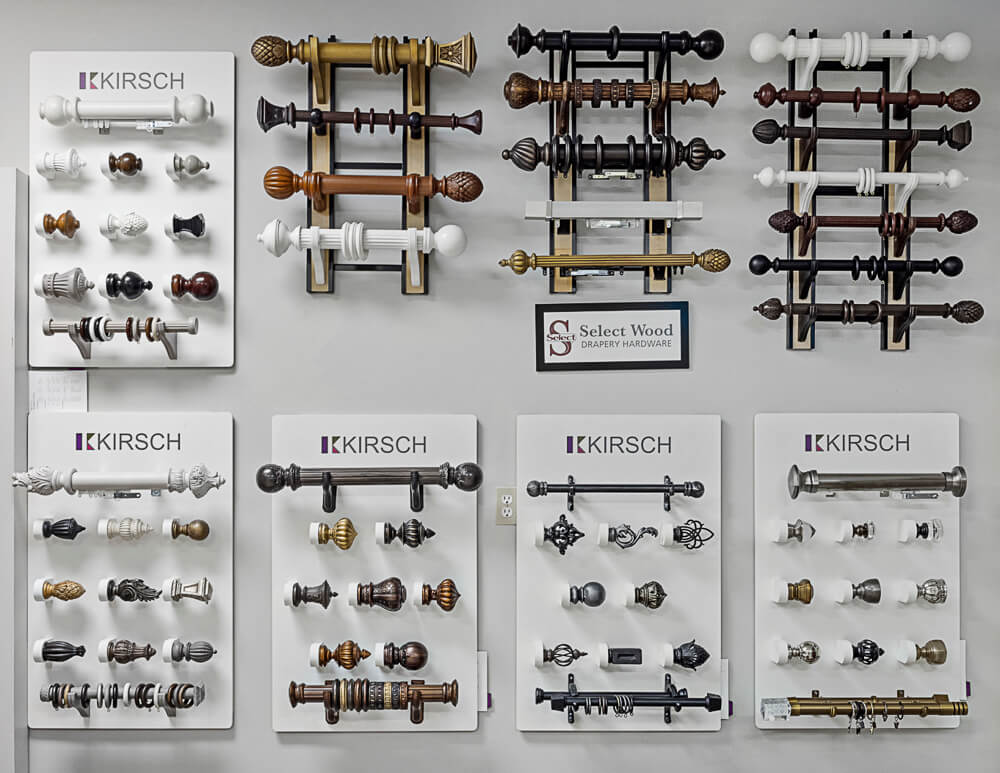Drapery Hardware
Dress Up Your Windows
Home interior design involves many aspects of your personal space, including the way that you dress up your windows. The treatments you choose, though, must be both pleasing to the eye as well as serve functional purposes, such as creating privacy, darkening the room, reducing energy bills, and buffering outdoor noises. However, it’s important also to consider the hardware that supports your window treatments when creating a functional and beautiful home interior.
When choosing the right drapery rods, you should take into account numerous variables to ensure that you select the right hardware for you.
Mass Market Hardware
While mass-produced drapery hardware is easily accessible and highly affordable, you should definitely think twice before purchasing it. The hardware that you see in stores is much different than the selection that is available for custom draperies.
Custom-made draperies will not work well on mass market hardware. The rod will bend, the brackets will disengage from the wall, or the rod will simply not fit with the panels. Draperies which are made specifically to suit your home are made of superior materials, which means that they will be thick and substantial. Mass-produced curtain rods are not made to support such weight and will struggle to uphold the high-quality fabrics and linings of your custom-made drapes.
Mass market hardware usually offers telescoping rods, which usually means that the material is thin to allow for one smaller side of the rod to slide into the larger hollow side. This thin metal is prone to sagging and the rings will typically catch on the connection point when opening or closing your curtains.
The rings or clips are not made to custom fit your drapes or your window size, and the brackets are bulky and unseemly, taking away from the overall effect of your interior design.
Functional Solutions
The functional aspect of your drapes can come into play when choosing hardware for your draperies. For instance, you may choose different layouts for your window treatment hardware depending on whether the drapes will be stationary or operable.
If you don’t plan to ever close the panels, you may want to install short rods on either side of the window. This will provide extra support for thick drapes as well as offering a beautiful design for large windows.
If you intend to open and close your drapes, a sturdy rod that extends across the entire length of the window is preferred. A ringless and cordless track rod provides a sleek, stylish look and is operated by pulling on hidden wands.
Selecting the Correct Drapery Rod Size
The size of the rod is an important factor when purchasing window treatment hardware. The length of the rod is obviously dependent on the window size; however, you should also consider the thickness of the hardware.
- A thin rod with a 1” diameter can be used for sheer curtains.
- A medium diameter of 1 ⅛” to 1 ⅞” is the typical rod size used for custom-made draperies.
- Large rods with a diameter of between 2” to 3” are often used in rooms with high ceilings or two-story windows because they match the scale of the space.
Choice of Materials
The style of your room will be a determining factor on the type of rod you should purchase. The design features of your room – such as wood, metal, or paint – will all come into play when choosing a finish for your drapery hardware. Balance out current textures and colors with window treatment hardware that complements these styles.
Ornamental finials, which decorate the ends of the rod, are available in a wide variety of colors, materials, and designs. These, too, can be used as a unique touch to add depth and harmonizing texture to your overall decor.
A variety of custom hardware choices are available for use in your home. Metal rods are popular in polished chrome, oil-rubbed bronze, and brushed nickel or gold. Wood rods can give a country or homey feel and look beautiful with a washed finish which reveals the grain design. Other popular hardware styles include French rods and acrylic rods with finials.

Shopping For Drapery Hardware
Even beyond mass market rods, buyers have a wide selection of options when purchasing drapery hardware for their home. Before making a final decision, you should consider three essential elements of your hardware: type, style, and application.
Type
Drapery hardware comes in two basic types: utility and decorative.
A utility rod is purely functional. It is used to hang draperies, curtains, or valances and has a minimal price. Since a utility rod is not meant to be seen, it has a simple design and is seen more as a tool than as a stylish feature.
A decorative rod, on the other hand, is meant to be visible and is designed with beauty and flair in mind. It is meant to add to the look and feel of the window treatment, whether it is drapes, sheers, valances, or other window coverings. Decorative rods with brackets and finials are more expensive and can be plain or extravagant in form.
Both utility and decorative hardware are available for functional window treatments that are opened and closed regularly as well as stationary panels that are meant to frame the window, but will not be moved.
Style
Utility rods typically have a simple design, because they aren’t meant to be seen. Decorative rods, on the other hand, come in a variety of styles to meld with your particular approach to interior design. For instance, wrought iron or metallic hardware and finials with a sleep appearance work best for contemporary or transitional styles. Opulent wood rods and ornamental finials are ideal for traditional or historically accurate styles. More often than not, today’s homes feature an eclectic style which represents the owner’s particular preferences, even though they do not fit into a specific style.
Application
In most cases, you’ll simply need a rod to fit a normal sized window. However, in some instances you’ll be required to locate hardware for special applications, such as ceiling mounted functional drapes, bay windows, or doors.
Connector hardware can be used with both wood and metal drapery rods so that the hardware – and the fabric panels – can span across large windows. Bay windows may require the use of corner connectors, which are available in both utility and decorative hardware.
Putting It All Together
Regardless of the type of draperies you are installing in your home, you will need to take the time to consider what type of hardware you will use. Custom drapes will provide a stylish accent to your home, but it’s important to consider the function and appearance of the drapery hardware that will hold the fabric in place.
Whether you choose decorative or utility rods, it’s important that you select high-quality options which will not bend or break like mass market options sometimes do. Consider not only the function of the rod, but also think about the style of the finials, which can add an elegant touch to the overall look and feel of your window treatments.



